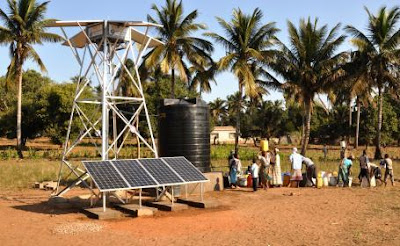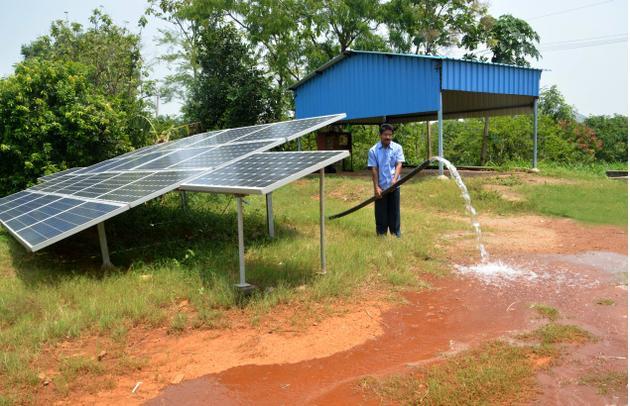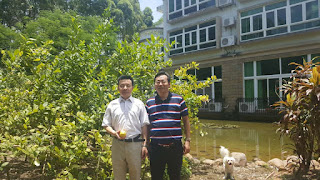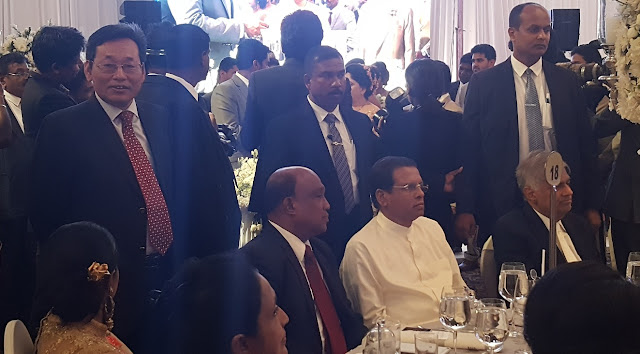Home / All Post
2017年6月30日星期五
2017年6月23日星期五
Over 12,000 solar pumps distributed to farmers in C'garh
 |
| 添加图片说明 |
During the meeting, the chief minister instructed the officials to focus more in 85 tribal-dominated development blocks for the distribution of the solar energy-based irrigation pumps, the official said
"About 12,161 solar powered pumps had been provided to the farmers till now against the target of 11,300 under 'Saur Sujala Yojna' since the inception of the scheme in November last year," an energy department official said here today.
Chief Minister Raman Singh was informed about the development under the scheme while he was chairing a review meeting of the energy department at his official residence today, he said.
Prime Minister Narendra Modi had launched the 'Saur Sujala' scheme on state’s foundation day on November 1, 2016 in Raipur.
It's aim was to strengthen agriculture by providing irrigation facilities, particularly where there is no power supply, and development of farmers in the state, he said.
During the meeting, the chief minister instructed the officials to focus more in 85 tribal-dominated development blocks for the distribution of the solar energy-based irrigation pumps, the official said.
Singh expressed satisfaction that the department had distributed more solar pumps than the set target and congratulated the officials, he said.
The CM further stressed on the need to cover 20,000 farmers under this scheme by the end of this year pointing that farmers belonging to remote areas and inaccessible regions, should be given priority while distribution.
Notably, farmers are being provided solar-irrigation pumps of 5-horsepower and 3-horsepower at heavily subsidized rates in the state.
Solar irrigation pump worth Rs 3.5 lakh (3hp) is being given to Scheduled Caste and Scheduled Tribe classes at the cost of Rs 7,000, to Other Backward Class (OBC) at Rs 12,000 and general category farmers at Rs 18,000.
The remaining amount is borne by the state government, he said.
Besides, the chief minister also directed the officials to complete electrification of all villages and hamlets by March next year.
Similarly, he also asked to complete the installation of 32 power substations being established in different parts of the state, by March next year.
These power substations will facilitate quality electricity supply in nearly 95 per cent areas of the state, the official said.
Meanwhile, the officials informed in the meeting that 4,105 solar pumps had been installed for providing drinking water purposes in the state and there is a proposal to install 1,886 more such pumps in near future.
Chairman of Chhattisgarh Power Holding Company Shivraj Singh and other officials were present on the occasion.
Over 12,000 solar pumps distributed to farmers in C'garh
2017年6月15日星期四
Uganda Starts Up First Solar Power Plant in Bid to Tap Renewables
 |
| In this photo taken June 30, 2016, a Ugandan worker levels the ground at a solar plant in Soroti about 300 kilometers east of Uganda capital Kampala. |
Uganda on Monday started up its first grid-connected, 10 megawatt solar power plant as the east African country moves to tap its renewable energy resources and expand its electricity generation capacity.
Funded by Norway, Germany, UK and the European Union, the $19 million plant was developed by Access Power and Eren Re, two energy sector investors based in Dubai and France respectively.
Uganda, a prospective crude oil producer of some 34 million people, generates about 850 megawatts of electricity, mostly from hydro power dams.
Officials have said they want to increase that capacity to 1,500 megawatts by 2018 and are seeking foreign investors to develop the country's non-traditional energy sources such as solar and geothermal.
The plant, a vast field of some 32,600 photovoltaic panels, is located in Soroti in northeastern Uganda and the electricity generated will help power at least 40,000 homes.
Last week Uganda signed a 90 million-euro ($95.55 million) loan deal with German development bank KfW and French government finance agency AFD to build a 45 megawatt (MW) power plant in the country's west.
2017年6月7日星期三
Solar water pumps provide water in power-hit areas
 |
| Solar water pumps provide water in power-hit areas |
As many parts of Odisha are experiencing acute scarcity of drinking water and over 500 piped water supply projects lying defunct, the State Government on Saturday directed the collectors to install solar pump sets in areas where power supply is erratic.
Low voltage and frequent disruption of power being a common feature during summer months across the State, non-availability of power makes it difficult to supply piped water to households.
The collectors have been advised to identify water scarcity areas where drinking water supply could be possible through solar water pumping system.
Chief Secretary AP Padhi gave this direction while reviewing the availability of drinking water and measures taken to meet the water need of people in water scarcity areas through video conference with the collectors.
Padhi asked the collectors to develop at least 10 solar water pumping systems in their districts without delay.According to Panchayati Raj department, piped water supply is provided to 38,445 out of 1.56 lakh habitations in the State. While the number of defunct piped water projects was 942 in April, the department claimed 432 have been repaired and water supply restored.
The majority of habitations of the State meet their drinking water need from 4,15,558 tubewells and sanitary wells.
Pending power bills are the other major reason behind these projects being non-operational. Though the State Government had directed power distribution companies not to discontinue power supply to water projects in case of unpaid dues, the order is not followed in most places, official sources said.
In the April review meeting of the Chief Minister, it was decided to expedite the process of installation of solar energy-based drinking water projects in the Integrated Action Plan (IAP) districts like Koraput and Malkangiri. However, the achievement in this front is very negligible.
In its three-year achievements report, the State Government said over 1.30 lakh habitations are fully covered and 25,946 villages are partially covered under drinking water supply schemes. All the partially covered villages will get piped water supply by 2018-19, the report added.
More info:Solar water pumps provide water in power-hit areas
2017年6月2日星期五
The president of MNE is at a party with President, Prime Minister of Sri Lanka
In May 2017, the president of MNE and his entourage was invited to attend a big party held by his friend during the period of his visit to Sri Lanka. The President and Prime Minister of Sri Lanka attended the party.
2017年5月25日星期四
Ujjain: Govt offers 90% subsidy on solar water pumps to farmers
Ujjain: Government of Madhya Pradesh and new and renewable energy department has launched a solar pump programme to solve power crisis in agriculture sector. The purpose of this programme is to enable round the clock power supply to farmers for irrigation purposes. Under the programme, farmers can get solar-powered pumps at subsidised rate and will have to bear only 10 per cent cost of the pumps while 90 per cent will be borne by the government.
Divisional commissioner MB Ojha instructed officials of Energy Development Corporation and agriculture department to endorse the programme vigorously and reach out to farmers and motivate them for installing pump as Ujjain division has received a target. The pumps will be available in one horse power to 10 horse power. As per the scheme, if a farmer goes for one HP pump of Rs 1.75 lakh then that farmer has to bear only Rs 17,500 while the government will pay the remaining amount. Till now, a total of 16 solar-powered pumps have been installed in the district covering villages Narvar, Bisakhedi, Malikhedi, Runija, Ghattiya, Taran, Mahidpur and at the office of council of agriculture research.
2017年5月19日星期五
Off-grid renewable energy storage market to be worth Rs16,500 crore

New Delhi: The energy storage market for off-grid renewable energy in India will be worth Rs16,500 crore by 2022, Delhi-based Council on Energy, Environment and Water (CEEW) said.
In an analysis released on Friday, the climate think-tank said rooftop solar alone will make up 80% of this, touching Rs13,000 crore. It stated that the battery market in India for renewable applications has been growing steadily with increasing renewable penetration across different segments.
“The Ministry of New and Renewable Energy’s target to install 10,000 micro-grid/500 MW of micro and mini-grids will offer an additional opportunity to the tune of Rs3,300 crore for battery manufacturers. Batteries are a critical component of micro/mini-grid systems, since 100% backup is often required to supply electricity to rural households during evening hours,” said the analysis.
The analysis also highlighted key challenges for battery manufacturers like high-technology costs and uncertainty around performance in Indian climatic conditions.
“While the need for managing intermittency of renewable energy is often highlighted, flexibility in our generation resources is desirable. This can come from various sources and energy storage technologies are just one among them. Though a number of projects for grid-connected storage are being called for, the markets that are served poorly by the existing grid—mobile towers in remote locations, petrol pumps, ATMs are easy pickings for storage systems to cater,” said Arunabha Ghosh, CEO, CEEW.
It emphasised that advanced battery technologies could support rapid deployment of rooftop solar installations in the commercial and industrial segment.
“Currently, the higher cost of energy storage solutions limits rooftop solar system installation to cater to base load. Solar PV systems with energy storage could be a potential replacement to existing diesel generators and it would also save about Rs4-5 per unit of electricity, compared to diesel, for industrial and commercial consumers,” the analysis added.
In June 2015, Prime Minister Narendra Modi led National Democratic Alliance government increased its solar power target from 20,000 MW to 1,00,000 MW by 2022. The total renewable power target set by government by 2022 is 175,000 MW.
Of the 100,000 MW solar power, 40 GW is targeted from rooftop solar alone. But progress has been very slow. As per a recent report, India’s total installed rooftop solar capacity is estimated at only 1,247 MW (till 31 December 2016) which is about 3% of the targeted 40 GW by 2022.
Storage is one of the problem areas in developing the renewable market.
The report further said that, “Though the solar segment offers a huge market opportunity for advanced battery technologies, manufacturers (and researchers alike) have some ground to cover in addressing technical limitations of batteries such as charging characteristics of a battery, thermal performance and requirement of boost current to charge deep cycle batteries”.
“Also, since solar companies directly procure batteries from manufacturers and require after sale services and technical support, battery companies should have wider presence to address these expectations,” it added.














